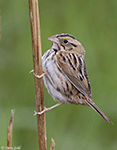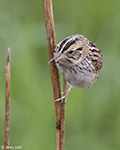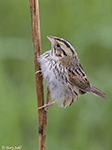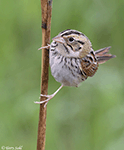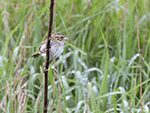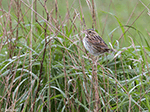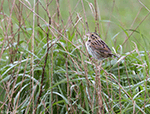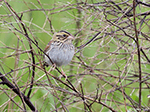| Length: 5 inches | Wingspan: 6.75 inches | Seasonality: Summer |
| ID Keys: Rusty-brown back and wings with dark streaks, olive-green wash on head, white undersides with dark streaks on sides and upper chest. | ||
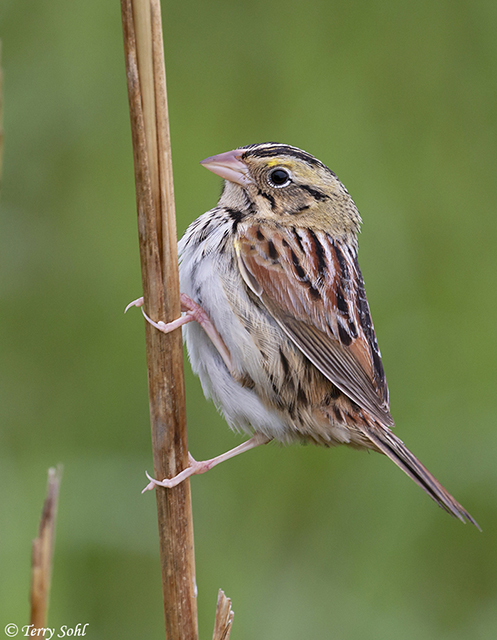 Henslow's
Sparrows are poorly understood birds of parts of the eastern and midwestern United States.
Populations have were in decline for several decades for reasons that weren't completely understood,
but habitat changes clearly contributed. Males will sing their incredibly short and
unremarkable song from high perches in weeds and shrubs during the summer, but
otherwise, they are very hard to observe as they typically forage on the ground
in thick weedy vegetation. Their normal breeding range is to the east of South
Dakota, with the closest reliable breeding locations in eastern Iowa. However,
while rare in South Dakota, they are sometimes seen during the summer months,
and it is possible breeding periodically occurs in the state. They are a
somewhat nomadic species as it is, with birds nesting in a location one year,
and absent the next.
Henslow's
Sparrows are poorly understood birds of parts of the eastern and midwestern United States.
Populations have were in decline for several decades for reasons that weren't completely understood,
but habitat changes clearly contributed. Males will sing their incredibly short and
unremarkable song from high perches in weeds and shrubs during the summer, but
otherwise, they are very hard to observe as they typically forage on the ground
in thick weedy vegetation. Their normal breeding range is to the east of South
Dakota, with the closest reliable breeding locations in eastern Iowa. However,
while rare in South Dakota, they are sometimes seen during the summer months,
and it is possible breeding periodically occurs in the state. They are a
somewhat nomadic species as it is, with birds nesting in a location one year,
and absent the next.
Habitat:
It is thought that population declines are due to habitat losses, but habitat requirements for the species are poorly understood. They are often found in weedy fields and meadows, often damp or marshy, with standing tall weeds and shrubs. They have also been found using abandoned pastures and farm fields.
Diet:
Insects and spiders make up most of the summer diet. Seeds also make up a portion of the diet, and may be the primary food item in the winter.
Behavior:
Does most of its foraging by walking along the ground, usually alone and not in flocks. Males will perch on exposed tall weeds and sing their very short and unremarkable courting song.
Nesting:
June and July. The nest of a Henslow's Sparrow is a shallow bowl, placed on the ground, typically in a shallow depression or in a protected location such as next to a clump of vegetation. It is constructed of grasses and weed stems, lined with finer grasses and/or hair. The female lays between 3 and 5 eggs, and she alone incubates them. The young hatch after about 12 days.
Song:
Strange monosyllabic hslick. Also a thin, monotone call.
1Click here to hear the song of a Henslow's Sparrow, recorded in Warrick County, Indiana
2Click here to hear the call of a Henslow's Sparrow, recorded in Washtenaw County, Michigan
Migration:
Summers throughout much of the Midwest, the eastern Great Lakes region, parts of the Mid-Atlantic, and parts of the eastern Great Plains. Winters in the southeastern U.S.
Interactive eBird Map:
Click here to access an interactive eBird map of Henslow's Sparrow sightings
Similar Species:
If seen well, there are distinctive characteristics that make the species readily identifiable, particularly if also accompanied by hearing the song of the bird. However, they can be confused with the following:
- Le Conte's Sparrow - Both Henslow's and Le Conte's Sparrows share the streaked back, fine streaks on the flanks and upper breast, head stripes, and facial stripes. Le Conte's Sparrows have a buffier appearance overall, while Henslow's Sparrows generally have a touch of an olive tone to the plumage on their head. Le Conte's Sparrows are buffy above the eye, while on a Henslow's Sparrow, a yellow mark above the eye intersects an olive-tan eyebrow. Both species have a stripe behind the eye, but Henslow's Sparrows also have a obvious "mustache" stripe, while any such marking on a Le Conte's is very faint. Finally, the bill of a Henslow's Sparrow is larger and more robust than a Le Conte's.
- Baird's Sparrow - Both species share a streaked back, and have similar facial patterns, with strong head stripes, a dark eyeline, and obvious mustache stripes. However, Baird's Sparrows are paler overall and lack the olive tones of a Henslow's Sparrow on the head. Baird's Sparrows also lack the yellow on top of the eye.
- Grasshopper Sparrow - Both species share the streaked back, stripes on the top of the head, and a yellow mark above the eye. However, Grasshopper Sparrows lack the fine streaking on flanks and upper breast. Both have a dark line behind the eye, but the Grasshopper Sparrow lacks the mustache stripe of a Henslow's Sparrow.
Conservation Status:
In the latter half of the 20th century, Henslow's Sparrows underwent sharp declines in total population. However, some of that change is related to, ironically, the a lessoning in human disturbance in the eastern part of the United States. A species of open areas, they undoubtedly benefited from the massive deforestation that occurred across the eastern US in the 19th century and first part of the 20th century. As forest areas were allowed to recover, less open space was available for species such as Henslow's Sparrows. Loss of grassland habitat also likely contributed to declines in the species, however. In recent years, it appears that populations are again increasing. They are found across a relatively wide geographic area and are common in parts of their range. Despite questions about conservation status, particularly at the state level, they are not listed as threatened or endangered, and the IUCN considers the Henslow's Sparrow to be a species of "least concern".
Further Information:
1) Michigan State Summary - Henslow's Sparrow
2) WhatBird - Henslow's Sparrow
3) Audubon Guide - Henslow's Sparrow
Photo Information:
Photo taken on May 19th, 2019 at Newton Hills State Park, South Dakota - Terry Sohl
Audio File Credits:
1Scott Gravette, XC468414. Accessible at www.xeno-canto.org/468414
2Nathan Pieplow, XC288577. Accessible at www.xeno-canto.org/288577
| Click on the map below for a higher-resolution view |
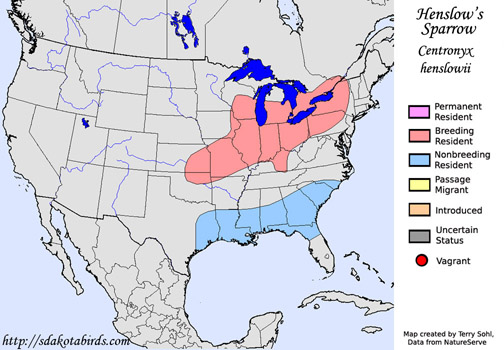 |
| South Dakota Status: Casual migrant and summer resident in the eastern part of the state. |
Additional Henslow's Sparrow Photos
Click on the image chips below to view the full-resolution images
